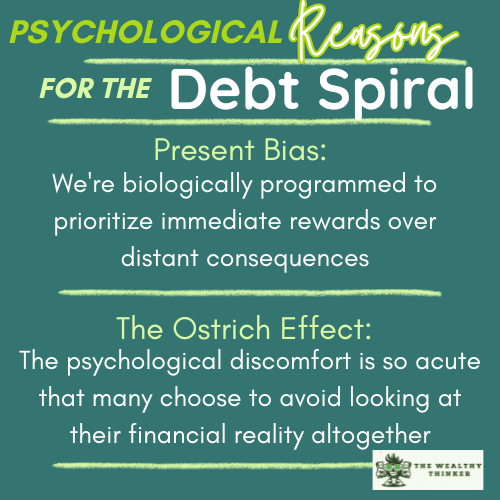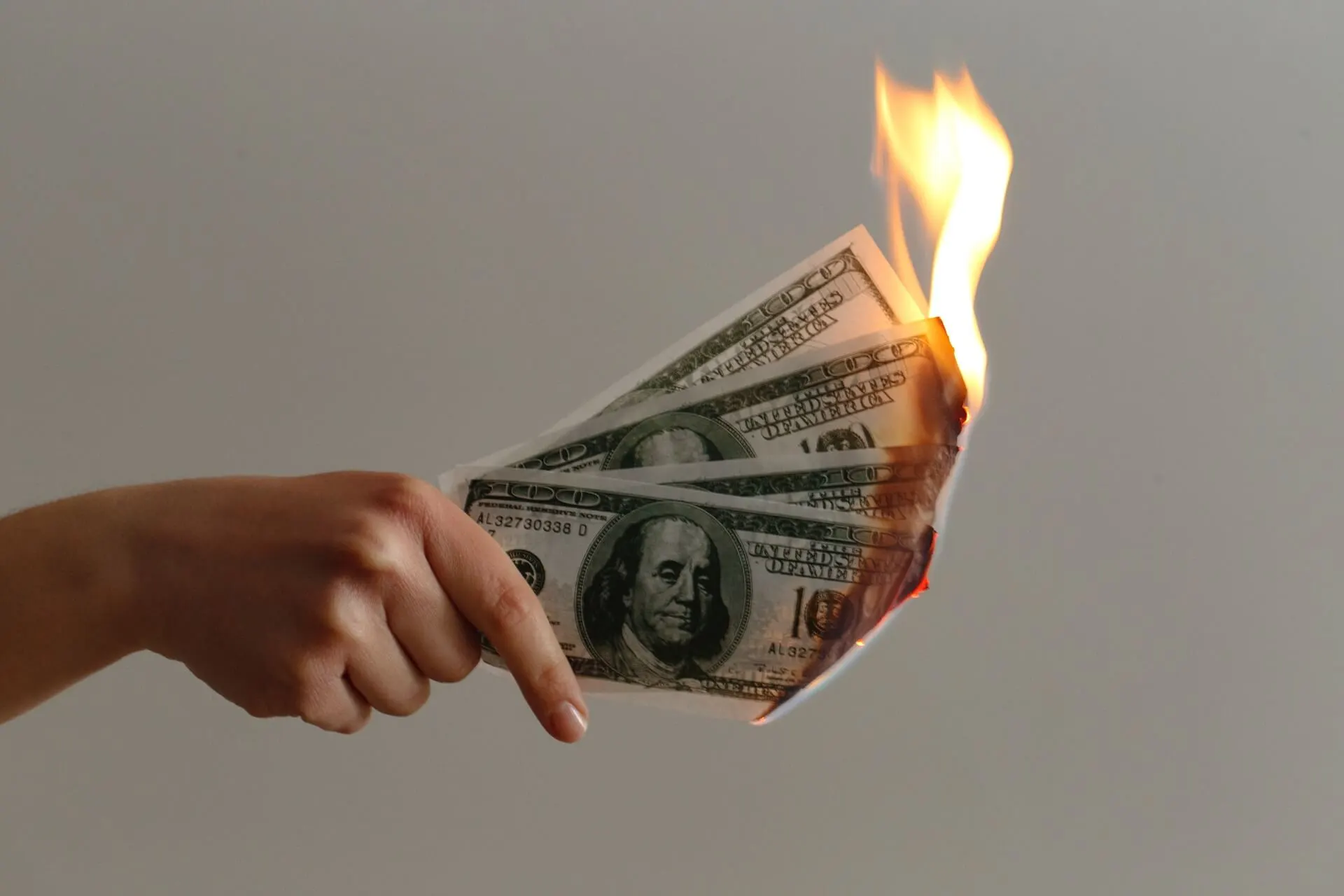The numbers don’t lie.
American consumer debt hit $18.04 trillion in 2024, with the average household carrying over $10,000 in credit card debt alone.
Student loans, auto financing, and mortgages push that number even higher.
Yet despite these sobering statistics, our spending continues unabated. We know we’re digging ourselves deeper, so why can’t we stop swiping those cards?
This isn’t just about math or financial literacy – it’s about human psychology, societal pressures, and emotional relationships with money that run deeper than most of us realize.
We’re biologically programmed to prioritize immediate rewards over distant consequences – a phenomenon psychologists call “present bias.”

Swipe, Regret, Repeat: The Psychology Behind America’s Debt Spiral
The Dopamine Economy
Each time we make a purchase, our brains release dopamine – the same neurotransmitter activated by food, sex, and certain drugs.
This biochemical reward system evolved to help our ancestors seek resources necessary for survival. But in our modern consumer society, this ancient wiring has been hijacked.
The moment we click “buy now” or hand over our credit card, we experience a rush of pleasure. This happens before we’ve even used the product. The anticipation alone triggers the reward.
This neurological hit is powerful and immediate, while the financial pain is delayed and abstract.
We’re biologically programmed to prioritize immediate rewards over distant consequences – a phenomenon psychologists call “present bias.” Credit cards exploit this tendency by further separating the pleasure of purchase from the pain of payment.
Social Comparison in the Digital Age
Humans are inherently social creatures who gauge their status relative to others.
Throughout most of human history, our comparison circle was limited to our immediate community. Today, social media has expanded that circle to include celebrities, influencers, and curated highlights from hundreds or thousands of connections.
When we scroll through Instagram, we’re not seeing the full financial reality behind those vacation photos, designer outfits, or renovated kitchens. We’re seeing highlights, often without context – the equivalent of comparing our behind-the-scenes footage to everyone else’s highlight reel.
Many people go into debt to maintain an appearance of prosperity. The correlation between social media use and impulse purchasing is particularly strong among millennials and Gen Z, who’ve grown up with these platforms.
This digital age keeping up with the Joneses creates a perception that everyone but you is living their best life, driving spending that often isn’t aligned with financial reality.
Financial Avoidance: The Ostrich Effect
For many, checking account balances or calculating total debt triggers genuine anxiety.
The psychological discomfort is so acute that many choose to simply avoid looking at their financial reality altogether – a phenomenon researchers call “the ostrich effect.”
A survey by the Financial Industry Regulatory Authority found that 58% of Americans feel anxious when thinking about their personal finances, and nearly two thirds report feeling stressed when checking their bank accounts.
This financial avoidance creates a destructive cycle:
We don’t look at our finances because it causes anxiety, but not looking allows problems to grow worse, increasing anxiety further.
Meanwhile, spending continues because without confronting the numbers, there’s no clear signal to stop.
The Myth of Future Self
Perhaps the most powerful psychological trick we play on ourselves is the belief that our “future self” will somehow:
- be more disciplined
- earn more money
- have fewer expenses than our present self
We tend to view our future selves as distant strangers. This psychological distance makes it easier to saddle that future version of ourselves with the consequences of today’s financial decisions.
This explains why it’s so easy to charge a vacation or new furniture set with the vague plan to “figure it out later.” We’re essentially passing the bill to someone else – a future version of ourselves who we subconsciously believe will be better equipped to handle the burden.
Consumption as Identity
In American culture especially, what we buy has become intrinsically linked to who we are.
Certain brands, experiences, and possessions serve as shorthand for our values, affiliations, and aspirations.
This identity-based consumption is particularly powerful for major life transitions.
New parents often feel pressure to buy the “right” stroller or create the perfect nursery. New homeowners believe they should immediately furnish and decorate to a certain standard.
Graduates entering professional life feel they need to dress, drive, and live in a way that reflects their new status.
During these transitions, debt often seems like an acceptable tool to quickly acquire the markers of a new identity, even when financial resources haven’t caught up to these expanded self-expectations.
Financial Literacy Gaps
While psychological and social factors play huge roles in our spending behavior, we can’t ignore a fundamental issue: many Americans simply lack basic financial education.
A survey by the Financial Industry Regulatory Authority found that only 48% of Americans could correctly answer four out of five basic financial literacy questions.
Topics like compound interest, inflation, and debt management aren’t covered adequately in most educational settings.
Without this foundation, many consumers don’t fully comprehend how carrying balances, making minimum payments, or taking on additional loans affects their long-term financial health.
Breaking the Cycle
Understanding these psychological and societal influences doesn’t excuse financial irresponsibility, but it does explain why traditional advice like “just spend less” often fails.
Addressing our national debt habit requires strategies that acknowledge these deeper forces:
- Practice financial mindfulness: Before purchases, pause to consider not just whether you can afford something, but why you want it. Is it serving a genuine need or filling an emotional void?
- Create friction: Remove saved payment information from shopping sites, delete shopping apps, and unsubscribe from retail emails to reduce impulsive spending.
- Find alternative dopamine sources: Identify free or low-cost activities that trigger the same pleasure response as shopping, whether that’s exercise, creative pursuits, or social connection.
- Audit your social media: Be conscious of how following certain accounts affects your spending desires and consider curating a feed that inspires financial wellness rather than consumption.
- Face the numbers: Schedule regular “money dates” with yourself to review your complete financial picture, ideally with support from a financially savvy friend or professional if anxiety is high.
America’s Debt Spiral: The Bottom Line
Our debt crisis isn’t simply a matter of poor decision-making or lack of willpower.
It’s the result of biological programming intersecting with powerful social forces and sophisticated marketing in an economy built on consumption.
Breaking free requires more than budgeting apps or financial literacy (though both help). It requires:
- recognizing and countering the invisible influences that drive our spending
- creating new habits that align with our authentic values
- developing a healthier relationship with money
Perhaps most importantly, it requires compassion – for ourselves and others caught in these powerful currents. Only by understanding the true complexity of our spending behaviors can we begin to change them.
Conscious Spending: Splurge on What’s Important, Save on What’s Not



















